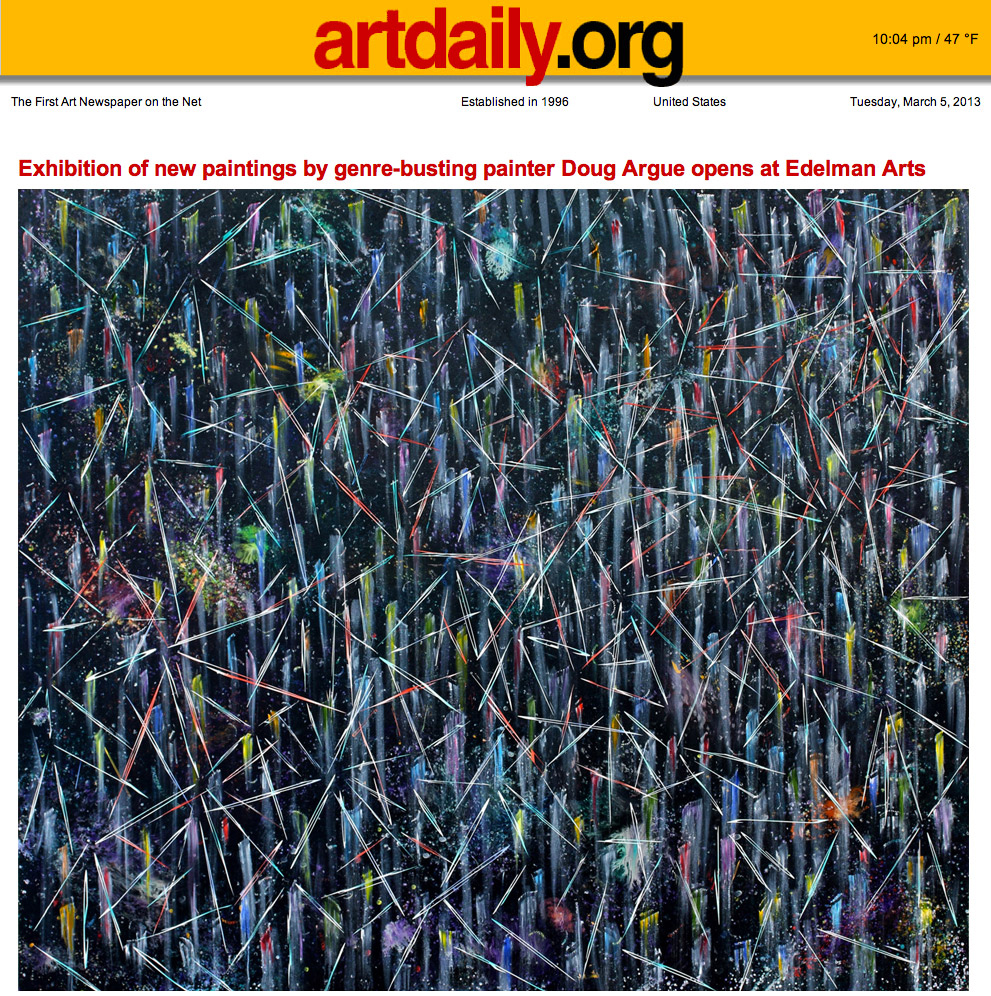
NEW YORK, NY.- Edelman Arts presents “The Art of Translation,” an exhibition of new paintings by genre-busting painter Doug Argue. The exhibit showcases the highly individual conceptual vocabulary Argue brings to his paintings. Asher Edelman, founder of Edelman Arts, believes “Argue’s work represents a totally new view of abstraction. Doug’s approach is as novel, and fully realized, as the works of Jasper Johns, Brice Marden and Jean-Michel Basquiat, at the height of their powers.”
The painter puts his unique vocabulary to work with a visual and conceptual subtext of letters. From a distance, the paintings suggest color field painting or abstract expressionism. A closer look reveals the paintings are comprised of prismatic realms of flowing shapes and patterns. Painted with oil on linen, the letterforms are individually stretched and transformed, capturing language’s ephemeral, fluid nature.
“What’s important to me is the flux of language—changing constantly in meanings, sound, grammar, in every way—and letters as metaphors for molecules, atoms, and chromosomes—providing a system of combining and recombining with almost infinite variation, while providing continuity in the evolution of the universe, life, and language. The letters also represent sounds. When I use them and break them up, they turn into free-roaming sounds.”
The paintings become life propositions: as much wave as particle. While Abstract Expressionists’ paintings were retrospective—capturing or reflecting a prior idea or emotional state—Argue’s paintings seem propositional, anticipatory—projecting into what the Frankfurt theorist Ernst Bloch terms the “not-yet.”
The letters for most of the show’s paintings are taken from the text of Herman Melville’s Moby Dick. The waves of letters in The Art of Translation come from the Greek (and its English rendering) of the first passages of the Iliad. The letters for Little Sorrows migrated to the canvas from 100 different poems.
As Argue traveled on the PATH train under the Hudson River from Manhattan to his Jersey City studio, to work on the new paintings, he read Herman Melville’s Moby Dick. The painter observes, “I view Moby Dick as an endless mine of letters. I don’t want random letters in my paintings: I want letters to originate from a primary source. Moby Dick becomes a sea of letters that flow into the paintings and give them sound and life and texture.”
While the words and letters have already undertaken an epic journey—from the mind of Melville, to his manuscript, to the printed text, to the digitized text relayed to the painter’s iPhone screen—in Argue’s works the original letters, stretched and pulled nearly beyond recognition, are embarking on a new voyage, into movement, shape, pattern and color.
Argue’s works are momentous in ambition and execution: at once forceful and intricate, physically powerful and ethereal, creations that explore the very essence of creation. Here is a painter on a journey: how fitting that Captain Ahab is along for the voyage.
Doug Argue (b. 1962) currently resides in New York City. His works are included in numerous public collections, including the Walker Art Center, the Minnesota Museum of American Art, the Minneapolis Institute of Arts, and the Frederick R. Weisman Art Foundation. In 2009, he was awarded with the Artist of the Year by the London International Creative Competition. Argue has been the recipient of a National Endowment for the Arts Fellowship, the Prix De Rome, a Bush Foundation Fellowship and a Pollock-Krasner Foundation Grant. Edelman Arts presented a solo exhibition of his works in 2011 and an exhibition of monumental works in conjunction with New York’s Haunch of Venison in June 2012.
“If the doors of perception were cleansed, everything would appear to man as it is, infinite. For man has closed himself up, till he sees all things thro’ narrow chinks of his cavern.”
William Blake, The Marriage of Heaven and Hell
This Post Has 0 Comments